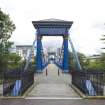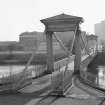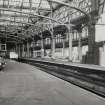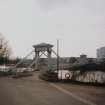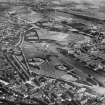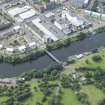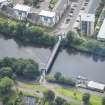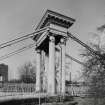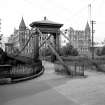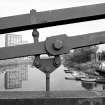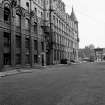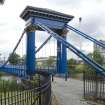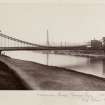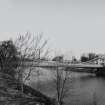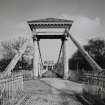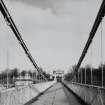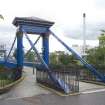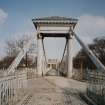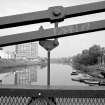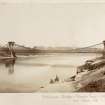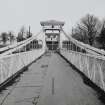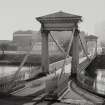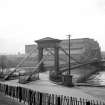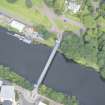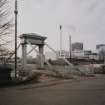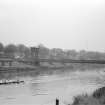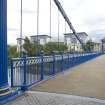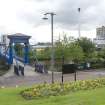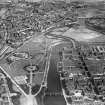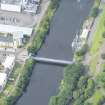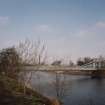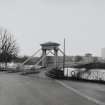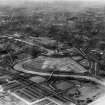Glasgow, Glasgow Green, St Andrew's Suspension Bridge
Suspension Bridge (19th Century)
Site Name Glasgow, Glasgow Green, St Andrew's Suspension Bridge
Classification Suspension Bridge (19th Century)
Alternative Name(s) River Clyde; Adelphi Street; St Andrew's Footbridge; Hutchesontown
Canmore ID 103492
Site Number NS56SE 157
NGR NS 59959 64002
Datum OSGB36 - NGR
Permalink http://canmore.org.uk/site/103492
- Council Glasgow, City Of
- Parish Glasgow (City Of Glasgow)
- Former Region Strathclyde
- Former District City Of Glasgow
- Former County Lanarkshire
NS56SE 157 59959 64002
St Andrew's Suspension Bridge [NAT]
OS 1:1250 maps, 1966 and 1968.
St Andrew's Suspension Bridge, built 1853-5, Neil Robson, engineer (£6348) to enable workers from Bridgeton and Calton to reach factories in Hutchesontown. The pylons consist of heavy entablatures supported by pairs of Corinthian columns, all of cast-iron. Flat link chains support a light lattice girder span. An attractive and little known structure.
J R Hume 1974.
(Suspension bridge of Samual Brown flat link type: location cited as NS 600 400). Built 1853-5 by Neil Robson, engineer. Cast-iron classical pylons, two flat-link chains (alternately 3 and 4 links wide) on each side, iron rod suspenders descending from both chains, light truss deck. Public footbridge.
J R Hume 1977b.
St Andrew's Footbridge. A wrought iron suspension bridge built in 1854-5 to replace a busy ferry, and not much altered since. Engineer Neil Robson of Glasgow; architect for the supporting pylons Charles O'Neill; contractor P and W McLellan. The spanning structure, 67m (220ft) over the river, is all of wrought iron, comprising chains of multiple flat links, suspender bars, and riveted deck structure. The pylons are portals of fine cast iron work, each with four fluted Corinthian columns almost 6m (20ft) high and correct enhtablature with the chains going through the frieze to their saddle supports. Cast iron lamp-standards also serve as posts for iron gates by which the portals can be closed. An excellent example of 1850's iron bridge construction.
E Williamson, A Riches and M Higgs 1990.
This bridge spans the River Clyde between Glasgow Green (to the NE) and Hutchesontown (to the SW); it is above the upper limit of tidal navigation. The river here forms the boundary between the parishes of Glasgow (to the NE) and Govan (to the SW).
The location assigned to this record defines the centre of the span. The available map evidence indicates that the bridge extends from NS 59988 64041 to NS 59931 63964.
Information from RCAHMS (RJCM), 16 December 2005.
Construction (1853 - 1854)
Project (2007)
This project was undertaken to input site information listed in 'Civil engineering heritage: Scotland - Lowlands and Borders' by R Paxton and J Shipway, 2007.
Publication Account (2007)
St Andrew’s Suspension Footbridge is a wrought-iron chain-link suspension bridge with classical style towers constructed in 1853–54 at Glasgow Green. Its span is 220 ft and the dip of the chains is about 22 ft. Each tower comprises two pairs of cast-iron Corinthian columns of 27 in. diameter and 20 ft high, each pair being capped
by a cage of 12 rollers on which rests a cast-iron plate to which the chains, which are 4 in. deep and in two tiers, are connected. The rod suspenders are connected to the chains by a Brunel-type attachment. The designer was Neil Robson and the contractor, P. & W. McLellan. The cost was £6348.
In the 1950s the original lattice parapet stiffening girders were replaced by more robust girders of the Warren type. There is a model with the original parapets in the Glasgow Museum of Transport.
R Paxton and J Shipway 2007
Reproduced from 'Civil Engineering heritage: Scotland - Lowlands and Borders' with kind permission of Thomas Telford Publishers.










































